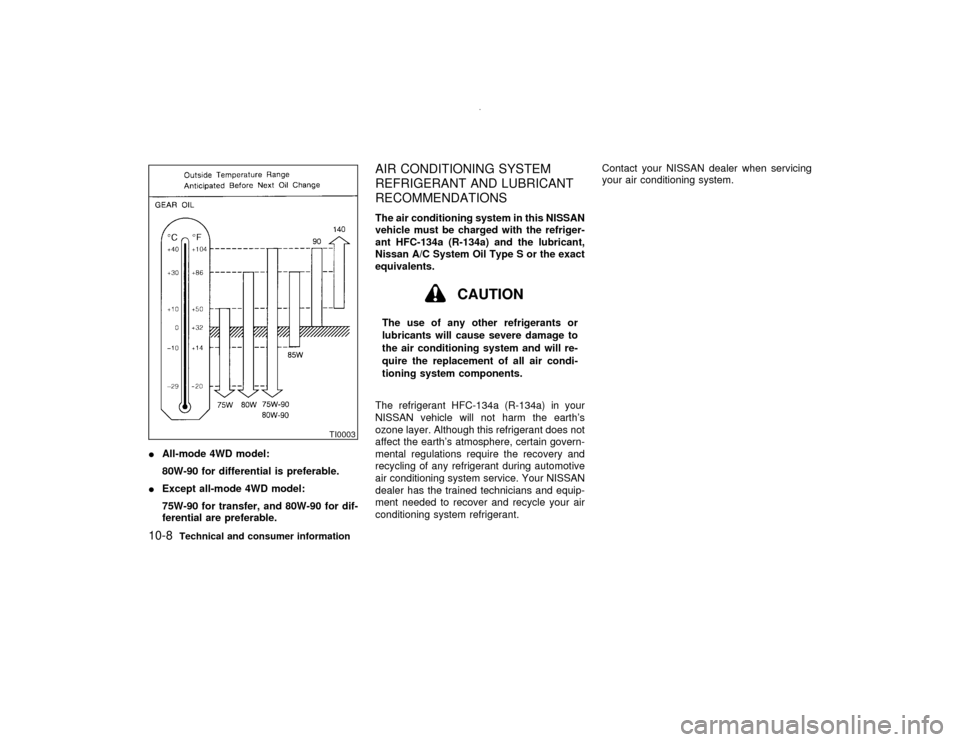2001 NISSAN PATHFINDER service
[x] Cancel search: servicePage 245 of 289

Your new NISSAN has been designed to have
minimum maintenance requirements with
longer service intervals to save you both time
and money. However, some day-to-day and
regular maintenance is essential to maintain
your NISSAN's good mechanical condition, as
well as its emission and engine performance.
It is the owner's responsibility to make sure
that the specified maintenance, as well as
general maintenance, is performed.
As the vehicle owner, you are the only one
who can ensure that your vehicle receives the
proper maintenance care. You are a vital link
in the maintenance chain.
General maintenance:
General maintenance includes those items
which should be checked during normal day-
to-day operation of the vehicle. They are es-
sential if your vehicle is to continue to operate
properly. It is your responsibility to perform
these procedures regularly as prescribed.
These checks or inspections can be done by
yourself, a qualified technician or, if you prefer,
your NISSAN dealer.
Periodic maintenance:
The maintenance items listed in this part are
required to be serviced at regular intervals.However, under severe driving conditions, ad-
ditional or more frequent maintenance will be
required.
Where to go for service:
If maintenance service is required or your
vehicle appears to malfunction, have the sys-
tems checked and tuned by an authorized
NISSAN dealer.
NISSAN technicians are well-trained special-
ists and are kept up to date with the latest
service information through technical bulletins,
service tips, and in-dealership training pro-
grams. They are completely qualified to work
on NISSAN's vehicles before they work on
your vehicle, rather than after they have
worked on it.
You can be confident that your NISSAN deal-
er's service department performs the best job
to meet the maintenance requirements on your
vehicle Ð in a reliable and economic way.During the normal day-to-day operation of the
vehicle, general maintenance should be per-
formed regularly as prescribed in this section.
If you detect any unusual sounds, vibrations or
smell, be sure to check for the cause or have
your NISSAN dealer do it promptly. In addition,
you should notify your NISSAN dealer if you
think that repairs are required.
When performing any checks or maintenance
work, see ªMaintenance precautionsº in the ª8.
Do-it-yourselfº section.
EXTERIOR MAINTENANCEAdditional information on the following
items with * is found in the ª8. Do-it-
yourselfº section.Outside the vehicleThe maintenance items listed here should be
performed from time to time, unless otherwise
specified.
Tires*:
Check the pressure with a gauge periodically
when at a service station, including the spare,
and adjust to the specified pressure if neces-
sary. Check carefully for damage, cuts or
excessive wear.
MAINTENANCE PRECAUTIONS GENERAL MAINTENANCE9-2
Maintenance
Z
00.1.10/R50-D/V5
X
Page 248 of 289

roads or to control dust. It is very important to
remove these substances, otherwise rust will
form on the floor pan, frame, fuel lines and
around the exhaust system. At the end of
winter, the underbody should be thoroughly
flushed with plain water, being careful to clean
those areas where mud and dirt may accumu-
late. For additional information, see ªCleaning
exteriorº in the ª7. Appearance and careº sec-
tion.
Fluid leaks:
Check under the vehicle for fuel, oil, water or
other fluid leaks after the vehicle has been
parked for a while. Water dripping from the air
conditioner after use is normal. If you should
notice any leaks or if gasoline fumes are
evident, check for the cause and have it cor-
rected immediately.To ensure smooth, trouble-free, safe and eco-
nomical driving, NISSAN provides two differ-
ent maintenance schedules that may be used,
depending upon the conditions in which you
usually drive. These schedules contain both
distance and time intervals, up to 60,000 miles
(96,000 km)/48 months. For most people, the
odometer reading will indicate when service is
needed. However, if you drive very little, your
vehicle should be serviced at the regular time
intervals shown in the schedule.
After 60,000 miles (96,000 km) or 48
months, continue periodic maintenance at
the same mileage/time intervals.
SCHEDULE 1Follow Periodic Maintenance Schedule 1 if
your driving habits frequently include one or
more of the following driving conditions:
IRepeated short trips of less than 5 miles
(8 km).
IRepeated short trips of less than 10
miles (16 km) with outside temperatures
remaining below freezing.
IOperating in hot weather in stop-and-go
rush hour traffic.
IExtensive idling and/or low speed driv-
ing for long distances, such as police,taxi or door-to-door delivery use.
IDriving in dusty conditions.
IDriving on rough, muddy, or salt spread
roads.
ITowing a trailer, using a camper or a
car-top carrier.
SCHEDULE 2Follow Periodic Maintenance Schedule 2 if
none of the driving conditions shown in Sched-
ule 1 apply to your driving habits.
PERIODIC MAINTENANCE
SCHEDULES
Maintenance
9-5
Z
00.1.10/R50-D/V5
X
Page 256 of 289

10 Technical and consumer informationCapacities and recommended fuel/lubricants ......... 10-2
Fuel recommendation ......................................... 10-4
Engine oil and oil filter recommendation ............ 10-6
Recommended SAE oil viscosity number .......... 10-7
Air conditioning system refrigerant and lubricant
recommendations ............................................... 10-8
Specifications .......................................................... 10-9
Engine ................................................................ 10-9
Wheels and tires ................................................... 10-11
Dimensions and weights .................................. 10-11
When traveling or registering your vehicle in another
country................................................................... 10-12
Vehicle identification ............................................. 10-12
Vehicle identification number (VIN) plate ......... 10-12
Vehicle identification number (Chassis
number) ............................................................ 10-12
Engine serial number ....................................... 10-13
F.M.V.S.S. certification label ............................ 10-13
Emission control information label ................... 10-14Tire placard ...................................................... 10-14
Air conditioner specification label ..................... 10-14
Vehicle loading information ................................... 10-15
Terms ............................................................... 10-15
Determining vehicle load capacity.................... 10-15
Loading tips ...................................................... 10-15
Towing a trailer ..................................................... 10-16
Maximum load limits ......................................... 10-16
Towing load/specification chart ........................ 10-18
Towing safety ................................................... 10-18
Uniform tire quality grading .............................. 10-20
Emission control system warranty ........................ 10-21
Reporting safety defects (US only) ....................... 10-21
Readiness for inspection/maintenance (I/M) test
(US only) ............................................................... 10-22
Owner's Manual/Service Manual order
information............................................................. 10-24
In the event of a collision ................................. 10-24
Z
00.1.10/R50-D/V5
X
Page 260 of 289

Octane rating tipsIn most parts of North America, you should use
unleaded gasoline with an octane rating of at
least 91 AKI (Anti-Knock Index) number
(VQ35DE engine) or 87 AKI (Anti-knock Index)
number (VG33E engine). However, you may
use unleaded gasoline with an octane rating
as low as 85 AKI (Anti-Knock Index) number in
these high altitude areas [over 4,000 ft (1,219
m)] such as: Colorado, Montana, New Mexico,
Utah, Wyoming, northeastern Nevada, south-
ern Idaho, western South Dakota, western
Nebraska, and that part of Texas which is
directly south of New Mexico.
Using unleaded gasoline with an octane
rating lower than stated above can cause
persistent, heavy spark knock. (Spark
knock is a metallic rapping noise.) If se-
vere, this can lead to engine damage. If you
detect a persistent heavy spark knock even
when using gasoline of the stated octane
rating, or if you hear steady spark knock
while holding a steady speed on level
roads, have your dealer correct the condi-
tion. Failure to correct the condition is
misuse of the vehicle, for which NISSAN is
not responsible.
Incorrect ignition timing will result in knocking,
after-run or overheating. This in turn maycause excessive fuel consumption or damage
to the engine. If any of the above symptoms
are encountered, have your vehicle checked at
a NISSAN dealer or other competent service
facility.
However, now and then you may notice
light spark knock for a short time while
accelerating or driving up hills. This is no
cause for concern, because you get the
greatest fuel benefit when there is light
spark knock for a short time.
Technical and consumer information
10-5
Z
00.1.10/R50-D/V5
X
Page 263 of 289

IAll-mode 4WD model:
80W-90 for differential is preferable.
IExcept all-mode 4WD model:
75W-90 for transfer, and 80W-90 for dif-
ferential are preferable.
AIR CONDITIONING SYSTEM
REFRIGERANT AND LUBRICANT
RECOMMENDATIONSThe air conditioning system in this NISSAN
vehicle must be charged with the refriger-
ant HFC-134a (R-134a) and the lubricant,
Nissan A/C System Oil Type S or the exact
equivalents.
CAUTION
The use of any other refrigerants or
lubricants will cause severe damage to
the air conditioning system and will re-
quire the replacement of all air condi-
tioning system components.
The refrigerant HFC-134a (R-134a) in your
NISSAN vehicle will not harm the earth's
ozone layer. Although this refrigerant does not
affect the earth's atmosphere, certain govern-
mental regulations require the recovery and
recycling of any refrigerant during automotive
air conditioning system service. Your NISSAN
dealer has the trained technicians and equip-
ment needed to recover and recycle your air
conditioning system refrigerant.Contact your NISSAN dealer when servicing
your air conditioning system.
TI0003
10-8
Technical and consumer information
Z
00.1.10/R50-D/V5
X
Page 264 of 289

ENGINE
Model VQ35DE VG33E
Type Gasoline, 4-cycle Gasoline, 4-cycle
Cylinder arrangement 6-cylinder, V-slanted at 60É 6-cylinder, V-slanted at 60É
Bore´Stroke in (mm) 3.760´3.205 (95.5´81.4) 3.602´3.268 (91.5´83.0)
Displacement
cu in (cm
3)213.45 (3,498) 199.84 (3,275)
Firing order 1-2-3-4-5-6 1-2-3-4-5-6
Idle speed rpm
See the ªEmission control
labelº on the underside of the hood.See the ªEmission control
labelº on the underside of the hood. Ignition timing (BTDC)
degree/rpm
CO percentage at idle speed
[No air] %
Spark plug PL FR5A-11 (Standard) FR4AP-10 (Hot)
PL FR4A-11 (Service option) FR5AP-10 (Standard)
PL FR6A-11 (Service option) FR6AP-10 (Cold)
Spark plug gap in (mm) 0.043 (1.1) 0.039 (1.0)
Camshaft operation Timing chain Timing belt*1
Alternator belt size
Width´Length
in (mm)0.8409´46.26 (21.36´1,175) 0.8409´41.93 (21.36´1,065)
*1: Periodic maintenance is necessary. See ªPeriodic maintenanceº in the ª9. Maintenanceº section for maintenance intervals.
SPECIFICATIONS
Technical and consumer information
10-9
Z
00.1.10/R50-D/V5
X
Page 275 of 289

However, for long steep grades, do not stay in
1st or 2nd gear when driving above 35 MPH
(56 km/h).
IIf the engine coolant rises to an extremely
high temperature when the air conditioning
system is on, turn off the air conditioner.
Coolant heat can be additionally vented by
opening the windows, switching the fan
control to high and setting the temperature
control to the HOT position.
ITrailer towing requires more fuel than nor-
mal circumstances.
IAvoid towing a trailer for the first 500 miles
(800 km).
IHave your vehicle serviced more often than
at intervals specified in the recommended
Maintenance Schedule.
When towing a trailer, change oil in the
transmission more frequently. See the
Maintenance Schedule.UNIFORM TIRE QUALITY
GRADINGDOT (Department of Transportation) Quality
Grades: All passenger car tire must conform to
Federal Safety Requirements in addition to
these grades.Quality grades can be found where applicable
on the tire sidewall between tread shoulder
and maximum section width. For example:
Treadwear 200 Traction AA Temperature A
TreadwearTreadwear grade is a comparative rating
based on tire wear rate when tested under
controlled conditions on specified government
test courses. For example, a tire graded 150
would wear one and a half (1-1/2) times as well
on the government course as a tire graded
100. However, relative tire performance de-
pends on actual driving conditions, and may
vary significantly due to variations in driving
habits, service practices and differences in
road characteristics and climate.Traction AA, A, B and CThe traction grades from highest to lowest are
AA, A, B, and C. Those grades represent the
tire's ability to stop on wet pavement as mea-
sured under controlled conditions on specified
government test surfaces of asphalt and con-
crete. A tire marked C may have poor traction
performance.
WARNING
The traction grade assigned to your ve-
hicle tires is based on straight-ahead
braking traction tests, and does not in-
clude acceleration, cornering, hydro-
planing, or peak traction characteristics.Temperature A, B and CTemperature grades are A (the highest), B,
and C. They represent a tire's resistance to
heat build-up, and its ability to dissipate heat
when tested under controlled conditions on a
specified indoor laboratory test wheel. Sus-
tained high temperature can cause tire mate-
rial to degenerate, reducing tire life. Excessive
temperatures can lead to sudden tire failure.
Grade C corresponds to a performance level
which all passenger car tires must meet under
the Federal Motor Vehicle Safety Standard No.
109. Grades A and B represent higher levels of
performance on laboratory test wheels than
the minimum required by law.
10-20
Technical and consumer information
Z
00.1.10/R50-D/V5
X
Page 279 of 289

A genuine NISSAN Service Manual is the best
source of service and repair information for
your vehicle. Filled with wiring diagrams, illus-
trations and step-by-step diagnostic and ad-
justment procedures, this manual is the same
one used by the factory trained technicians
working at authorized NISSAN dealerships.
Also available are genuine NISSAN Owner's
Manuals, and genuine NISSAN Service and
Owner's Manuals for older NISSAN models.In the USA:
For current pricing and availability of genuine
NISSAN Service Manualsfor the 2000 model
year, contact:
Tweddle Litho Company
1-800-639-8841
www.nissan-techinfo.com
For current pricing and availability of genuine
NISSAN Service Manualsfor the 1999 model
year and prior, see an authorized NISSAN
dealer, or contact:
DDS Distribution Services, Ltd.
20770 Westwood Dr.
Strongsville OH 44136
1-800-247-5321For current pricing and availability of genuine
NISSAN Owner's Manualsfor the 2000
model year and prior, see an authorized
NISSAN dealer, or contact:
DDS Distribution Services, Ltd.
20770 Westwood Dr.
Strongsville OH 44136
1-800-247-5321
In Canada:
To purchase a copy of a genuine NISSAN
Service Manual or Owner's Manual please
contact your nearest NISSAN dealer. For the
phone number and location of a NISSAN
Dealer in your area call the NISSAN Satisfac-
tion Center at 1-800-387-0122 and a bilingual
NISSAN representative will assist you.
Also available are Genuine NISSAN Service
and Owner's Manuals for older NISSAN mod-
els.
IN THE EVENT OF A COLLISIONUnfortunately, accidents do occur. In this un-
likely event, there is some important informa-
tion you should know. Many insurance compa-
nies routinely authorize the use of non-
genuine collision parts in order to cut costs,
among other reasons.
OWNER'S MANUAL/SERVICE
MANUAL ORDER INFORMATION10-24
Technical and consumer information
Z
00.1.10/R50-D/V5
X